Insert and format autoshapes
Insert an autoshape
To add an autoshape on a slide,
- in the slide list on the left, select the slide you want to add the autoshape to,
- click the Shape icon at the Home or Insert tab of the top toolbar,
- select one of the available autoshape groups: Basic Shapes, Figured Arrows, Math, Charts, Stars & Ribbons, Callouts, Buttons, Rectangles, Lines,
- click on the necessary autoshape within the selected group,
- in the slide editing area, place the mouse cursor where you want the shape to be put,
Note: you can click and drag to stretch the shape.
- once the autoshape is added you can change its size, position and properties.
Note: to add a caption within the autoshape make sure the shape is selected on the slide and start typing your text. The text you add in this way becomes a part of the autoshape (when you move or rotate the shape, the text moves or rotates with it).
It's also possible to add an autoshape to a slide layout. To learn more, please refer to this article.
Adjust autoshape settings
Some of the autoshape settings can be altered using the Shape settings tab of the right sidebar. To activate it click the autoshape and choose the Shape settings icon on the right. Here you can change the following properties:
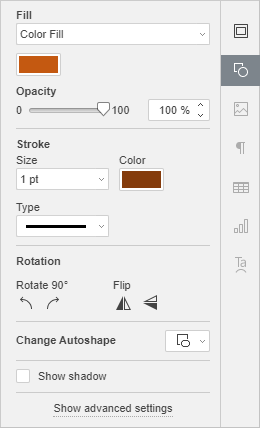
To change the advanced settings of the autoshape, right-click the shape and select the Shape Advanced Settings option from the contextual menu or left-click it and press the Show advanced settings link at the right sidebar. The shape properties window will be opened:

The Size tab allows to change the autoshape Width and/or Height. If the Constant proportions button is clicked (in this case it looks like this ), the width and height will be changed together preserving the original autoshape aspect ratio.

The Rotation tab contains the following parameters:
- Angle - use this option to rotate the shape by an exactly specified angle. Enter the necessary value measured in degrees into the field or adjust it using the arrows on the right.
- Flipped - check the Horizontally box to flip the shape horizontally (left to right) or check the Vertically box to flip the shape vertically (upside down).
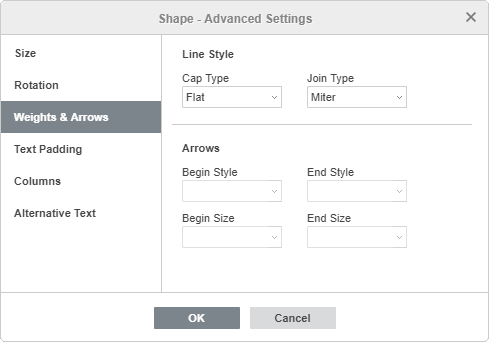
The Weights & Arrows tab contains the following parameters:
- Line Style - this option group allows to specify the following parameters:
- Arrows - this option group is available if a shape from the Lines shape group is selected. It allows to set the arrow Start and End Style and Size by selecting the appropriate option from the drop-down lists.
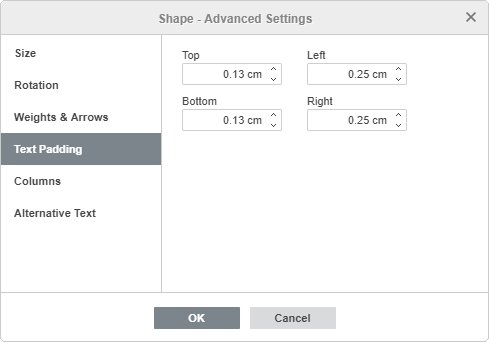
The Text Padding tab allows to change the autoshape Top, Bottom, Left and Right internal margins (i.e. the distance between the text within the shape and the autoshape borders).
Note: this tab is only available if text is added within the autoshape, otherwise the tab is disabled.
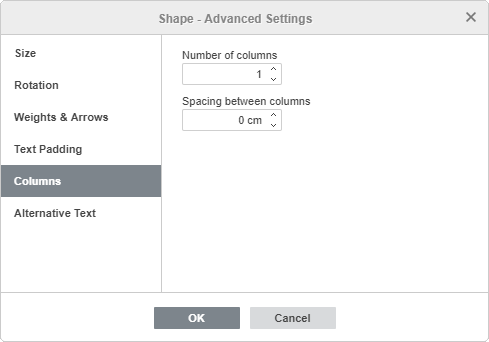
The Columns tab allows to add columns of text within the autoshape specifying the necessary Number of columns (up to 16) and Spacing between columns. Once you click OK, the text that already exists or any other text you enter within the autoshape will appear in columns and will flow from one column to another.
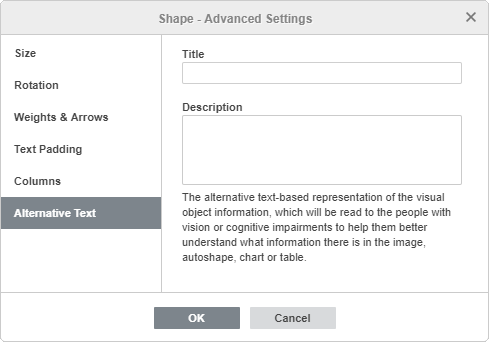
The Alternative Text tab allows to specify a Title and Description which will be read to the people with vision or cognitive impairments to help them better understand what information there is in the shape.
To replace the added autoshape, left-click it and use the Change Autoshape drop-down list at the Shape settings tab of the right sidebar.
To delete the added autoshape, left-click it and press the Delete key on the keyboard.
To learn how to align an autoshape on the slide or arrange several autoshapes, refer to the Align and arrange objects on a slide section.
Join autoshapes using connectors
You can connect autoshapes using lines with connection points to demonstrate dependencies between the objects (e.g. if you want to create a flowchart). To do that,
- click the Shape icon at the Home or Insert tab of the top toolbar,
-
select the Lines group from the menu,

- click the necessary shape within the selected group (excepting the last three shapes which are not connectors, namely Curve, Scribble and Freeform),
-
hover the mouse cursor over the first autoshape and click one of the connection points that appear on the shape outline,
-
drag the mouse cursor towards the second autoshape and click the necessary connection point on its outline.
If you move the joined autoshapes, the connector remains attached to the shapes and moves together with them.
You can also detach the connector from the shapes and then attach it to any other connection points.
Alla pagina precedente